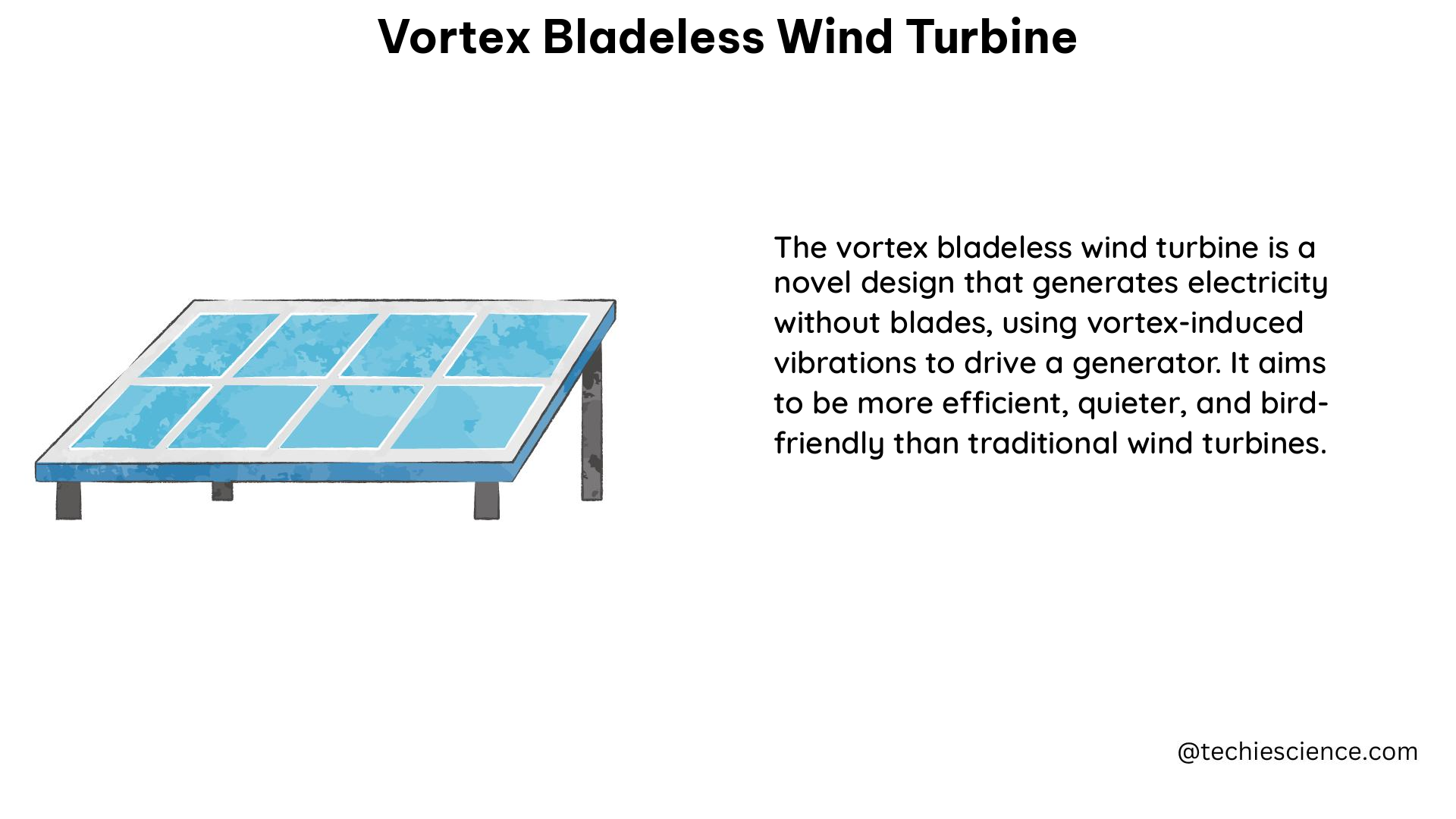The Vortex Bladeless Wind Turbine (VBWT) is a revolutionary approach to harnessing wind energy, characterized by its unique bladeless design and the utilization of vortex-induced vibrations (VIV) for power generation. This innovative technology stands in stark contrast to traditional wind turbines, which rely on rotating blades to capture wind energy.
Design and Components of the VBWT
The VBWT comprises three primary components: a fixed base, a cylindrical mast that oscillates freely perpendicular to the wind direction, and a carbon rod that connects the base and the mast. The key feature of this design is that the inner parts of the VBWT never come into physical contact with one another, allowing for a simpler construction and reduced maintenance requirements compared to conventional wind turbines.
The cylindrical mast of the VBWT is typically made of a lightweight, high-strength material, such as carbon fiber or fiberglass, to optimize its oscillation characteristics. The mast’s diameter can range from 15 to 30 centimeters, and its height can vary from 12 to 25 meters, depending on the specific application and wind conditions.
Fluid-Structure Interaction

The VBWT harnesses energy through a phenomenon known as Vortex Shedding, which occurs when wind flows around a structure and creates alternating vortices of pressure. The frequency of these vortices is directly related to the wind speed, and if the natural resonating frequency of the mast matches the vortex shedding frequency, the mast begins to oscillate. This oscillation is the key to the VBWT’s energy generation process.
The relationship between the wind speed and the vortex shedding frequency is described by the Strouhal number, a dimensionless parameter that depends on the mast’s geometry and the Reynolds number (a measure of the fluid flow regime). By carefully designing the mast’s dimensions and material properties, the VBWT can be tuned to resonate at the optimal frequency for a given wind speed range.
Energy Conversion
The VBWT converts the oscillations of the mast into electrical energy using a similar principle to traditional alternators. The mast is equipped with a series of coils and magnets, which generate an electrical current through electromagnetic induction as the mast vibrates. The magnets also serve as a “Tuning System,” modifying the apparent elasticity constant of the mast and expanding the wind speed range in which oscillations occur.
The power output of a VBWT is directly proportional to the square of the oscillation amplitude and the cube of the wind speed. Experimental studies have shown that the VBWT can achieve a coefficient of power (Cp) of approximately 0.3, which is comparable to the performance of traditional wind turbines.
Optimization and Performance
Researchers have conducted extensive studies to optimize the performance of VBWTs. One key factor is the aspect ratio (height-to-diameter ratio) of the mast, which has been found to significantly impact the power generation capabilities. Higher aspect ratios, typically in the range of 12 to 20, have been shown to result in increased power output.
Additionally, the placement and orientation of the VBWT relative to the prevailing wind direction can also influence its performance. Numerical simulations and experimental tests have demonstrated that the optimal orientation is with the mast perpendicular to the wind flow, as this configuration maximizes the vortex-induced vibrations and energy harvesting.
Environmental Impact and Advantages
The VBWT offers several environmental benefits compared to traditional wind turbines. Its bladeless design eliminates the risk of bird and bat strikes, a significant concern with conventional wind turbines. Furthermore, the VBWT requires fewer materials for its construction, reducing the overall environmental footprint and resource consumption.
Another advantage of the VBWT is its reduced noise emissions compared to traditional wind turbines. This makes the VBWT a more suitable option for urban areas and environmentally sensitive locations, where noise pollution is a concern.
Conclusion
The Vortex Bladeless Wind Turbine represents a promising alternative to conventional wind energy technologies. Its innovative design, based on the principles of vortex-induced vibrations, offers the potential for reduced maintenance costs, improved environmental compatibility, and comparable energy generation performance. As research and development in this field continue, the VBWT may emerge as a viable solution for a more sustainable and efficient wind energy future.
References
- Hamdan, H.; Dol, S.S.; Gomaa, A.H.; Tahhan, A.B.A.; Al Ramahi, A.; Turkmani, H.F.; Alkhedher, M.; Ajaj, R. Experimental and Numerical Study of Novel Vortex Bladeless Wind Turbine with an Economic Feasibility Analysis and Investigation of Environmental Benefits. Energies 2024, 17, 214.
- Francis, S.; Umesh, V.; Shivakumar, S. Design and Analysis of Vortex Bladeless Wind Turbine. Mater. Today Proc. 2021, 47, 5584–5588.
- Nguyen, T. Bladeless wind turbines – Sustainable Development Goals. Sustainable Development Goals 2016, 56(16), 1351-1371.
- A state-of-art review on Bladeless Wind Turbine – IOPscience. IOPscience 2019, 1950(1), 012058.
- Vortex Bladeless Turbine – Reinventing wind energy! [Internet]. Vortex Bladeless Wind Power. [cited 14 December 2021]. Available from: https://vortexbladeless.com/

The lambdageeks.com Core SME Team is a group of experienced subject matter experts from diverse scientific and technical fields including Physics, Chemistry, Technology,Electronics & Electrical Engineering, Automotive, Mechanical Engineering. Our team collaborates to create high-quality, well-researched articles on a wide range of science and technology topics for the lambdageeks.com website.
All Our Senior SME are having more than 7 Years of experience in the respective fields . They are either Working Industry Professionals or assocaited With different Universities. Refer Our Authors Page to get to know About our Core SMEs.